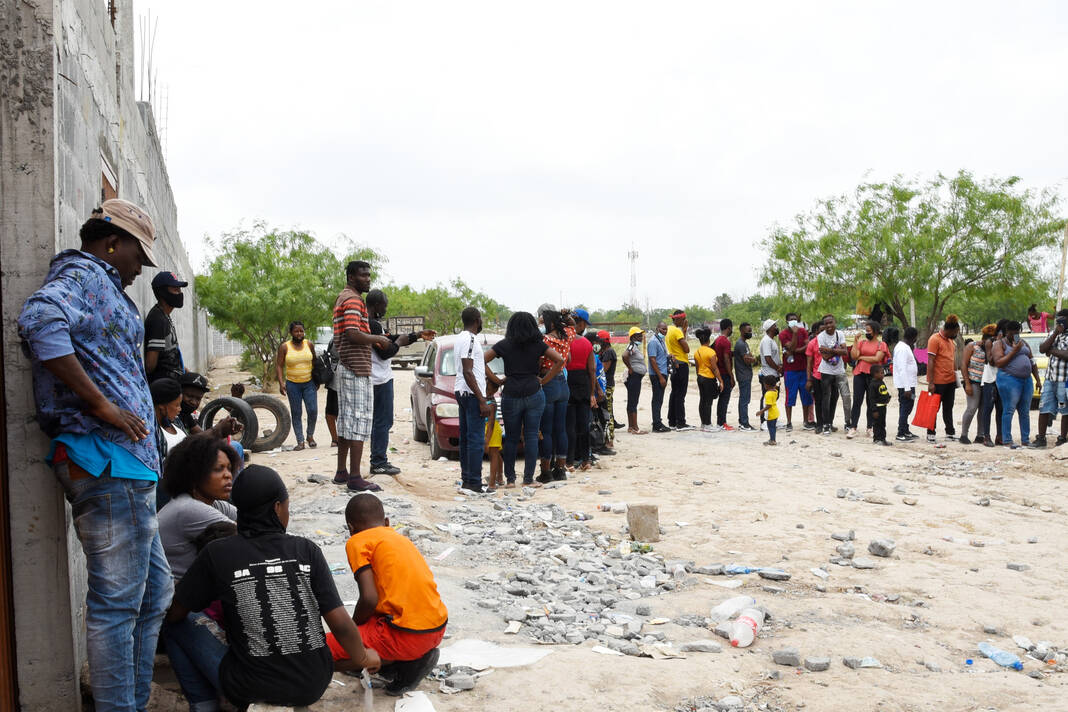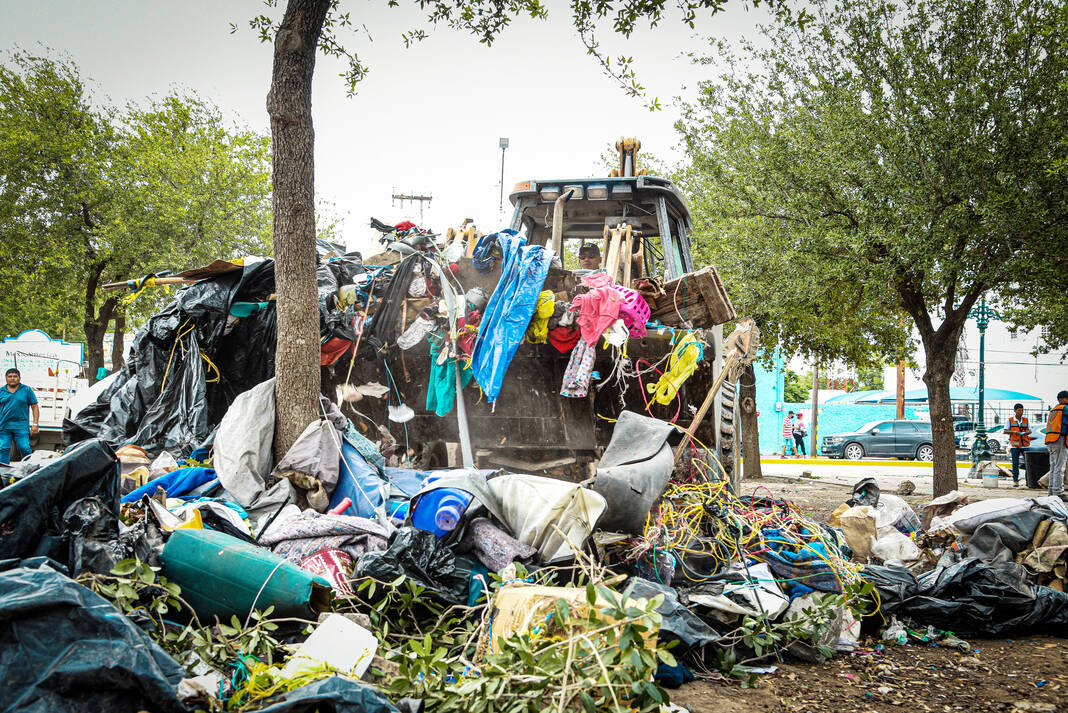
City officials in Reynosa cleared out a migrant encampment sheltering hundreds of migrant families and attempted to relocate them early Tuesday morning. Yet, hundreds more arrived over the last couple days, complicating the math and introducing chaos into the fragile process.
A bulldozer scraped the Plaza de la Repulica’s dirt floor amassing the remnants of migrants’ lives who called the plaza, a block away from the international bridge, home for more than a year.
Discarded pills, clothes, a plastic tricycle, and tangles of nylon strings once used to hold up tarps were scooped up in the giant machinery that raked the public space before Reynosa’s mayor arrived to announce the noticeable change.
“We were able to dismantle this plaza which is emblematic and important for Reynosa residents and for our visitors from the Valley who see this upon first crossing through the international bridge,” Carlos Víctor Peña Ortiz, Reynosa’s mayor, said before a crowd of reporters.
Peña Ortiz credited the coordination between certain nongovernmental organizations and his administration with the successful operation.
Dozens of city employees continued working while the mayor and other city leaders expounded their decision to take down the encampment formed by thousands of migrants sent back from the U.S. or waiting to cross and seek asylum when a pandemic-induced policy barring them is removed at the end of May.
While thousands at one point found themselves stranded in the plaza, the latest census taken by non-governmental organizations, like the Sidewalk School, suggested a little over 400 people remained.
As cameras and reporters encircled the mayor during the news conference, a Haitian couple who arrived four months ago in Reynosa, gazed from a park bench. The wife’s head was in her hands; her husband sat in a dejected slump.
Nicolas, 37, from Haiti, said he and his wife came because they heard a lot of people were crossing into the United States from Reynosa, in spite of Title 42, a public health policy that expels most migrants immediately back into Mexico.
They’ve been waiting to enter into a shelter, Senda de Vida, for three months.
Around midnight Tuesday, Nicolas said they saw the inhabitants of the camp form a long line after they agreed to relocate to Senda de Vida about half a mile away, soon after the dismantling began.
When Nicolas and his wife arrived at the shelter, he noticed the crowd was sorted out to give those who lived at the plaza priority at Senda de Vida.
“There’s room for everyone,” a city employee interjected as Nicolas spoke.

In spite of capacity claims, hundreds of migrant families, mostly Haitians, were seen Tuesday morning surrounding the entrance to Senda de Vida and the new shelter that was near completion, Senda de Vida II.
Senda de Vida’s director, Pastor Hector Silva, credited the increase in Haitians to false rumors.
As Silva visited the site of the new shelter, he took a break, took a water bottle and sat under a tree with migrants seeking his help.
Silva borrowed a phone from an immigrant man nearby and explained they communicated with each other about migrants crossing into the U.S. through Reynosa, attracting more crowds to the region.
“And now he’s suffering,” Silva said, pointing to another man, “because he heard a false alarm.”
Silva and his counterpart, Sister Norma Pimentel of Catholic Charities of the Rio Grande Valley, helped coordinate the move from the plaza.
Pimentel said in recent weeks, more migrants indeed were allowed to legally cross into the U.S. through humanitarian paroles, a process in place even through the pandemic.
“In the meantime, we started to see a decrease of people in the plaza, because they had been allowed to enter the United States through the ports of entry in a controlled, small amount of people every day,” Pimentel explained. “So, numbers at the plaza started to decrease.”
Senda de Vida’s population also shrank, allowing space for the incoming migrants remaining at the camp. The plan, which was not disclosed publicly, was thwarted when the rumors caught up to Reynosa.
“In the last two weeks, it was almost as if they were a couple, and all of a sudden there’s everybody,” Pimentel said, referring to the number of Haitians. “The numbers have really increased a lot, especially in Reynosa. I’ve never seen so many Haitians, ever.”
Desperate mothers sat outside the new shelter, Senda de Vida II, as Pimentel, Silva, Peña Ortiz, and a consulate met to discuss the situation behind closed doors.
“It’s very dangerous here,” Lourdes, 36, a mother of two from Haiti, said nervously. She didn’t want to share her identity fearing for her safety. She was kidnapped in 2015 back in Haiti and was drugged as she rode in a Tijuana bus.
The Reynosa mayor said migrants like her have the opportunity to work in the city to earn a living. Lourdes had already received a work permit but said she was unable to keep afloat.
“I live on the streets, but why am I on the street? Because the rent is too high,” she explained. “They’re asking us for $5,000 pesos a month for rent, but we don’t have it. The jobs pay us about $1,500 to $1,700 pesos a week. … I am part of a family of four. We have to eat.”
She was one of several families who spent the night waiting to fit into the new shelter.
As of Tuesday evening, Senda de Vida II remained officially closed. Although, after the meeting, several large camping tents were erected on the far end of the site.

Pimentel estimated it may take a few more days to get the electricity needed at the new shelter before families can be allowed in. The shelter will depend on temporary housing, like tents, and will function as a holding place for migrants who seek to move into Senda de Vida I where some legal services are offered.
Critics understand the city’s decision to clear out the plaza but disagree on the method.
“It’s chaos,” Anderson, a Haitian man in his 30s, said. He was fortunate to find shelter in the newly open Kaleo International shelter that takes in migrant families like his. “Conditions in the plaza were very rough,” he recalled from his nearly one-month stay there.
“I think the initiative was right, but leaving some stranded was wrong,” Anderson opined.
The need in the Kaleo Shelter drastically increased overnight when nearly 50 people were taken off the street and given a place to stay after they were displaced. Water was scarce Tuesday afternoon, and worries circulated over having enough food.
Soon after the shelter opened, many began crowding outside its doors. Beds, tents, clothing, water and food are in high demand and short supply. Kaleon International is seeking donations through its partner, the Sidewalk School.
Pastors with the Sidewalk School dedicate their time to the education of migrant children in the plaza. On Tuesday afternoon, they looked out the window of a room filled with construction paper cutouts from the children they may never see again.
“They’re children fleeing from danger,” Pastor Liliana Carlos said. “They arrive to form a home, and then suddenly, the little they have — be it an old and dirty doll, or some worn-out shoes — just imagine their loss after loss. The U.S. is going to have a serious problem if they don’t address the mental health of these children.”
Monitor staff writer Francisco E. Jimenez contributed to this report.
Hundreds of Reynosa migrants displaced after shelter suddenly dismantled




